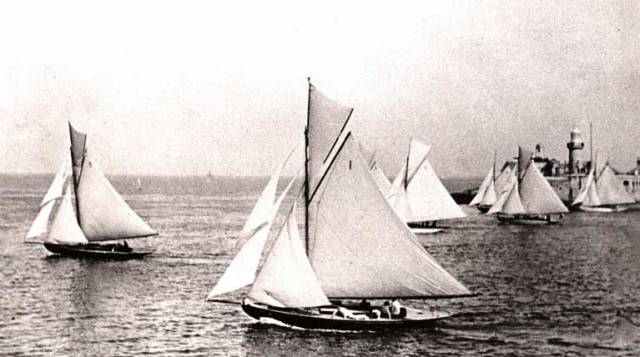Our header photo this week may not be the greatest in terms of clarity and technical brilliance, let alone jaw-dropping drama writes W M Nixon. But it tells us much about our peculiar sport of racing under sail, that two genuine and experienced sailing enthusiasts could examine this photo in detail and argue for hours about whether it is a Good Thing, or a Travesty of Sporting Justice.
It shows the Dublin Bay 25 class making a start through the mouth of Dun Laoghaire Harbour, which would have been Kingstown when the image was taken, as it’s probably pre-1914. But even were it in the 1920s or ’30s, many of the locals – including, one would think, practically everyone on these yachts - continued to call it Kingstown even though it had officially reverted to Dun Laoghaire in 1920, meaning that it had been Kingstown for just 99 years.
Be that as it may, it shows a classic summer’s day - probably a Saturday afternoon, though they had racing on some weekday afternoons too in the GODs (the Good Old Days) – and an easterly sea breeze is making as the 25ft LWL class, the aristocrats of the Dublin Bay One Design scene and the J/109s of their time, get their race under way.
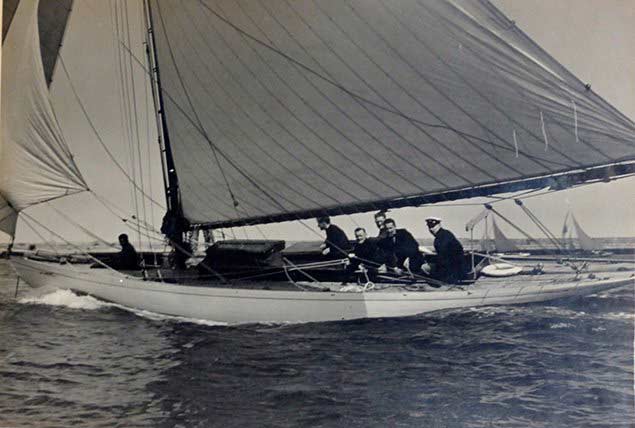 The J/109s of their day – the Purcell brothers’ DB 25 Acushla racing on Dublin Bay in 1938. An early owner was the legendary international tenor John McCormack, and Macushla was one of his most popular songs
The J/109s of their day – the Purcell brothers’ DB 25 Acushla racing on Dublin Bay in 1938. An early owner was the legendary international tenor John McCormack, and Macushla was one of his most popular songs
It may well be that their actual start was made in-harbour from a mark boat off the waterfront for the convenient viewing of the many members and their guests in the distinguished clubhouses (who would have observed proceedings for about four minutes as it was otherwise interrupting their lunch, but never mind). Thus it might be said that in accessing Dublin Bay through the harbour mouth, they were getting two starting lines for the price of one.
But either way, the last thing on anyone’s mind was the thought that people should go to much trouble – or indeed any trouble whatever – to provide a starting line which was at exactly 90 degrees to the basic wind direction. On the contrary, the thinking at virtually all sailing centres was that you should get the boats away as quickly and conveniently as possible from a start line near their moorings, and finish them in similar style. For in those pre-auxiliary-engine days, finishing at some distance from home with the wind failing was a big turn-off in every sense of the term, and it was certainly bad for club racing’s popularity.
Anyway, that header photo, which is such a long up the page by now that we’ll show it again, would seem to suggest that the boat on the left – no 2, Punctilio which was the last DB25 to leave Dun Laoghaire, she was here until the 1970s – is well set up, as they’re probably racing towards a first mark in mid-bay. She’s nicely on a closer-than-close reach but not actually hard on the wind, she’s just hitting the edge of the seaward-going ebb which will sharpen the breeze and enable her to sail at the optimum angle, and she looks to have freed herself from getting any dirt from the group close under the east pier.
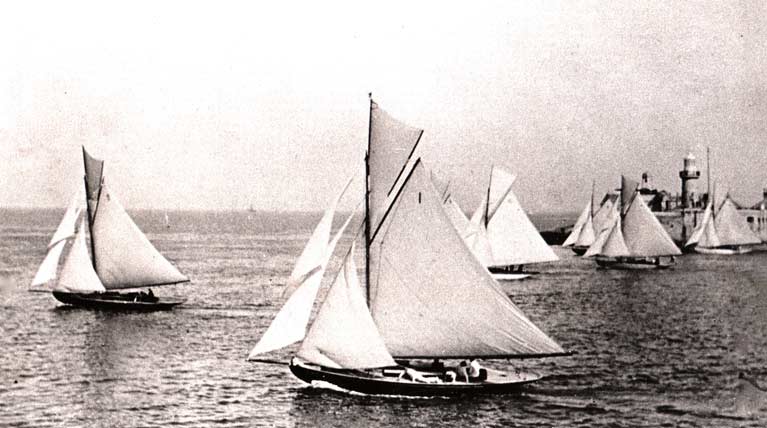 Here’s that start again for further examination
Here’s that start again for further examination
But don’t dismiss them entirely. The boat right under the lighthouse may be carrying her way with limp sails through a small calm spot. But within seconds she will be getting a benefit from the mini tide rip which swirls round the pier end, and suddenly her overall position could be transformed.
For in the GODs, the boat which has had the best start was the boat which was best placed after about a mile of racing. And who knows, but it might even be the boat in the foreground, No 1 which could either be Whisper built in 1898 by local shipwright J E Doyle, or it could be Fodhla built in 1903 also by J E Doyle.
For Fodhla was built for the Viceroy, the Earl of Dudley and the nascent 25ft class were so chuffed that Himself up in The Park was getting one of the boats (it was a surprise present from his wife) that they decided Fodhla should also be No 1. Only in Dublin Bay would they have two No 1s, while they never ever had a No 13.
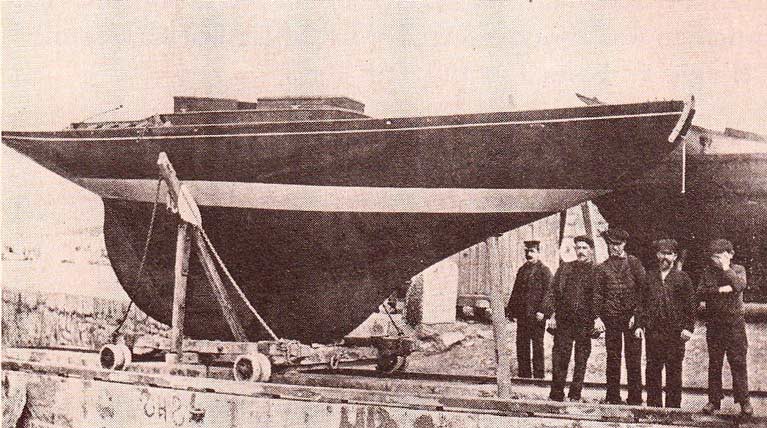 The new Fodhla ready for launching by builder J E Doyle into the Coal Harbour in what was then Kingstown in 1903. As the owner-to-be was the Viceroy, the class association caused eternal confusion by making her No 1 when they already had a No 1, built in 1898. Photo courtesy DBSC.
The new Fodhla ready for launching by builder J E Doyle into the Coal Harbour in what was then Kingstown in 1903. As the owner-to-be was the Viceroy, the class association caused eternal confusion by making her No 1 when they already had a No 1, built in 1898. Photo courtesy DBSC.
Anyway, Fodhla or Whisper or whatever is going like a train as she carries a private puff of breeze from within the harbour, but you’ll notice that her racing flag atop the jackyard tops’l suggests she is reaching, yet they already have her trimmed for the wind being well ahead of the beam, in anticipation of the significantly different direction outside.
Or it could be we’re flattering No 1’s crew? Maybe they’ve been surprised by this sudden puff from abeam or even slightly aft of it. But as it’s only going to last for a few seconds until they get into the basic breeze in the bay, it’s hardly worth their while adjusting the four different sheets which the complex rig of the DB25 requires, and it’s only going to cause confusion with the sister’s son, young Willie, who is trying to make himself comfortable in the sunshine on the lee deck, and fell overboard last time out, costing them a couple of places……
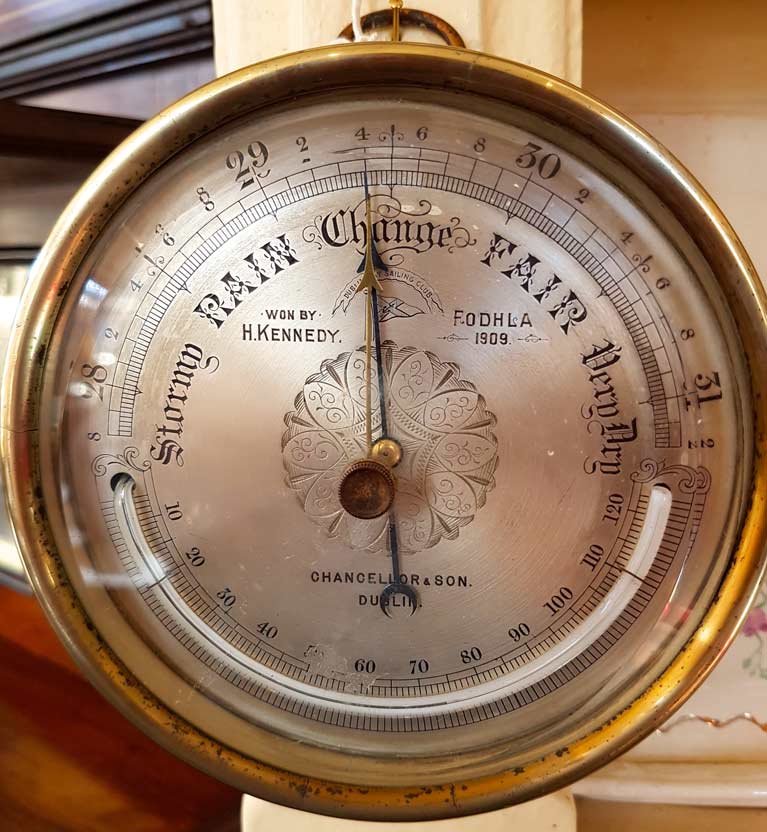 Fodhla was only briefly in the ownership of the Viceroy – by 1909 she was winning races for one H Kennedy, as this DBSC prize barometer from Vandeleur Antiques of Kilrush reveals.
Fodhla was only briefly in the ownership of the Viceroy – by 1909 she was winning races for one H Kennedy, as this DBSC prize barometer from Vandeleur Antiques of Kilrush reveals.
Be that as it may, we’re assuming one of our experienced observers is a sailor who enjoys racing which is as much an interaction with coastal features and local quirks of sea and weather as it is with the straightforward achieving of boat speed in clear relatively tide-free water, and he or she sees this start as a delightful challenge.
But equally we assume the other is a purist whose highest ideal is Olympic sailing in waters as interference-free as possible, with courses of a very set type with a starting line virtually at 90 degrees to the wind, which must be of minimal strength and steady direction, racing round marks well clear of any land influence with minimal and preferably no tide, and putting the emphasis on windward-leeward courses in which the crews are always busy busy busy. He or she, therefore, sees this start as a lazy luck-reliant shambles.
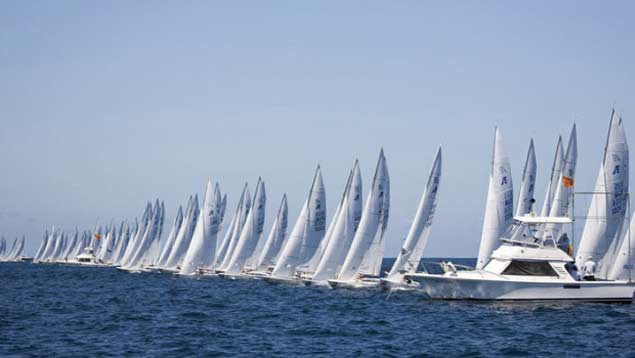 The beau ideal of a modern start, far at sea and dead to windward, with an extra mark boat at mid-line set back a very few feet to keep the sighted line in order
The beau ideal of a modern start, far at sea and dead to windward, with an extra mark boat at mid-line set back a very few feet to keep the sighted line in order
Inevitably, in an era when public awareness of sailing just about extends to Olympic medals and no further, the Olympic disease is spreading down to every level of our sport. Characterful starting huts on the end of piers or on picturesque shoreside seapoints, both with eminently sensible transit markers setting the line, are discarded in favour of Committee Boats, mark-laying RIBs, and a general support cast of dozens of pious folk including, God help us, umpires…...
"the Olympic disease is spreading down to every level of our sport"
Even back in the 1990s, it was sometimes at the stage where there seemed to be more people on the management side than were actually racing the boats. But the 1990s being the final years of that prelapsarian era before 24/7 electronic communication meant that you now never knew when you actually have time off, even though I was churning out verbiage at a ridiculous rate for many printed publications with the odd book to make things truly manic, deadlines meant that was it - job done and goodbye, you were all clear, and some civilised diversion could be planned without a thought for what should be going onto some ever-active communication screen.
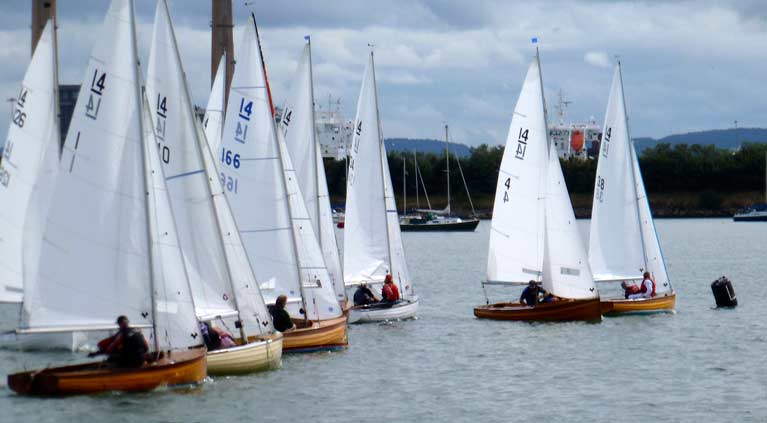 A spectator-friendly start for the IDRA 14s at Clontarf for their 70th Anniversary Race in 2016 in an area which dries out at low water. The line had been set from the shore to give a slight disadvantage to starboard tack boats, but a sudden backing of the light breeze accentuated this. Nevertheless the start proceeded, and while Andy Sargent in Dusk (no 4) has pulled off the port tack start, Gerry Sargent in Starfish is just able to make the pin on starboard, and he went on to win with Dusk second. Photo: W M Nixon
A spectator-friendly start for the IDRA 14s at Clontarf for their 70th Anniversary Race in 2016 in an area which dries out at low water. The line had been set from the shore to give a slight disadvantage to starboard tack boats, but a sudden backing of the light breeze accentuated this. Nevertheless the start proceeded, and while Andy Sargent in Dusk (no 4) has pulled off the port tack start, Gerry Sargent in Starfish is just able to make the pin on starboard, and he went on to win with Dusk second. Photo: W M Nixon
So anyway, after one particularly exasperating Race Week when the Organising Committee had insisted the Race Officer set the start line well away from harbour or any land, meaning we spent half the day getting there and back, I used the grapevine of the club bars to air an idea about a race among like-minded souls which would involve no Race Officer, and for its marks would rely only on islands (of which we have more than most folk realize in the Greater Dublin area), and on the navigation buoys of Irish Lights and Dublin Port.
Admittedly its successful functioning was reliant on inter-boat VHF, but for some years on the second Saturday of May, a handy flotilla of proper cruiser-racers in the 35-40ft range would get together for what we called The Islands Race in the morning sunshine (of course the sun always shone), and we’d talk ourselves into a sort of line and race round an island or two and a hefty steel buoy or three and end up somewhere agreeable like Skerries if the tide was right, or Poolbeg (when we ran up the Liffey under spinnaker right under the Hailing House to avoid the tide - you definitely couldn’t do that nowadays) or into Dun Laoghaire and an entertaining call to one of the clubs, or the Howth section might make the effort and get across to Dun Laoghaire and we’d all talk ourselves into a race back to Howth, maybe going round Dalkey Island and perhaps Ireland’s Eye on the way.
 The coastline of Greater Dublin is well blessed with convenient islands and other fixed turning marks
The coastline of Greater Dublin is well blessed with convenient islands and other fixed turning marks
It was perfect. But it was too good to last. Crews were returning home much too clearly demonstrating that they’d been having a lovely time. And the main official programme was expanding to spread into the shoulders of the season, taking up those early-May Saturdays, with Tim Goodbody in the Royal Alfred YC developing the season-long Superleague for cruiser-racers, which inevitably became a must-do series.
Our little idea lasted maybe half a dozen years. But with some people trying to make it more structured, while others who didn’t really fit the mould wanting to join, it was gently let go as we observed much-loved straightforward events such as the traditional Lambay Race degenerating into a cat’s cradle of windward starts and additional marks which confused simple mariners who knew very well indeed how to race round islands, but couldn’t get too excited about VMG towards some distant artificially-planted buoy.
For inevitably, the business of starting and running yacht races was becoming a mini-industry within itself, a mini-industry whose functioning adds to the time spent in actually getting in a decent little race which should be over and done with from about a quarter of an hour after leaving port, to within minutes of finishing.
It is something which is causing concern throughout sailing, but before we attempt a truly disruptive revolution and try to Make Sailing Simple Again, may I take another slight diversion?
For I have long wished to declare that the greatest benefactor of the human race is the inventor of golf. The thinking behind such a notion is this: What on earth would all those people be doing if they didn’t have golf to play? It helps to keep them moderately fit, and though it may result in artificially green spaces, from seaward or up in the hills an artificially green space in pleasant countryside is infinitely preferable to industrial or urban sprawl.
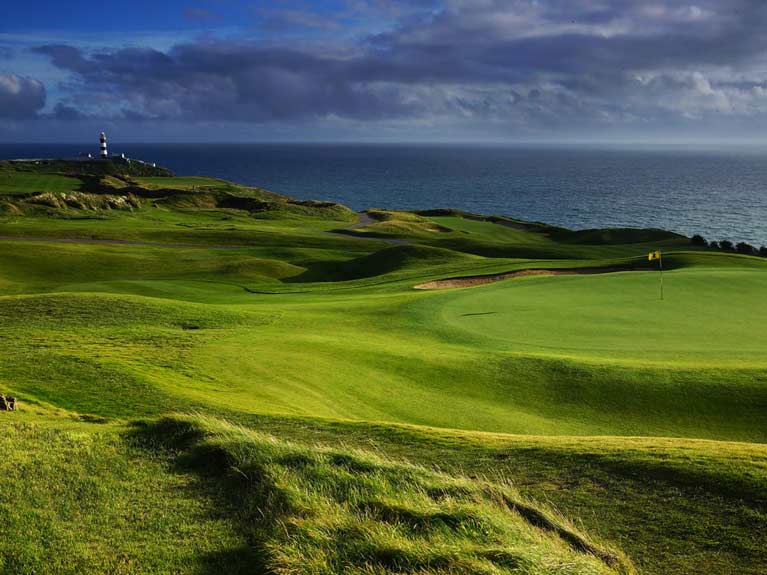 The Old Head Golf Course near Kinsale – it may be very artificially green, but it is preferable to industrial or urban sprawl
The Old Head Golf Course near Kinsale – it may be very artificially green, but it is preferable to industrial or urban sprawl
As for the people for whom golf is pleasantly sedating, they cause trouble to no-one. An experienced hotelier in the west of Ireland once told me that the golfer is the perfect guest, easily pleased if you’ve the proper hospitality skills, and no trouble to anyone. He or she will return to the inn in a relaxed frame of mind after one or two rounds of their beloved game, and for dinner they’ll invariably have a steak with a bottle of red wine. Then they’ll retire peacefully to their rooms maybe with another bottle or a pint of Guinness, and there they’ll settle down in bed and watch a golf video before sleeping serenely.
It’s an entire segment of society kept content with a sense of purpose. So when the disruptors talk of doing away with distantly-located “perfect” start lines and Race Officers who will not let the fleets away until a dozen wind requirements are fully met, do they (the disruptors) not have enough humanity in them to think about what might become of the not-inconsiderable corps of volunteers who currently man committee boats and back-up RIBs and mark boats and heaven only knows what else that floats and can usefully be deployed to ensure that a smaller number of people actually get in some sort of race?
For the fact of the matter is, a fully-crewed and effectively-equipped and properly-organised Committee Boat with its various support boats is arguably a floating Men’s Shed (and yes, I know there are many splendid women involved too, God bless them).
So if we go back to simple shore-based starts using transits as Nature intended rather than having fully-manned boats bobbing about at sea, what on earth is going to become of those who have been called to Committee Boat service? For it’s not for everyone – it’s a sort of secret society, and there’s an invisible vetting process.
Either way, if we just pack a race officer into a little pier-end hut with a time-keeper and a records secretary and set up the transits for a reasonable start and then let the sailors at it within a few yards of the harbour mouth, we’re inevitably going to cast all those Committee Boat folk, mark buoy boys, and umpires into a sort of purposeless outer darkness.
Perhaps they can take up golf…..Meanwhile, before this column is swamped into obliteration under an onslaught of Olympic Sailing Purity of Opinion, let it be pointed out that the Round Ireland Race starts from a shoreline, though admittedly with the race officer at the outer end in a Naval Service vessel if there’s one available. Elsewhere, much of Cowes Week and all of the Fastnet Race starts from a fixed shoreline. And as for the course, that’s then sailed, very little of it is round artificial marks other than established navigation buoys.
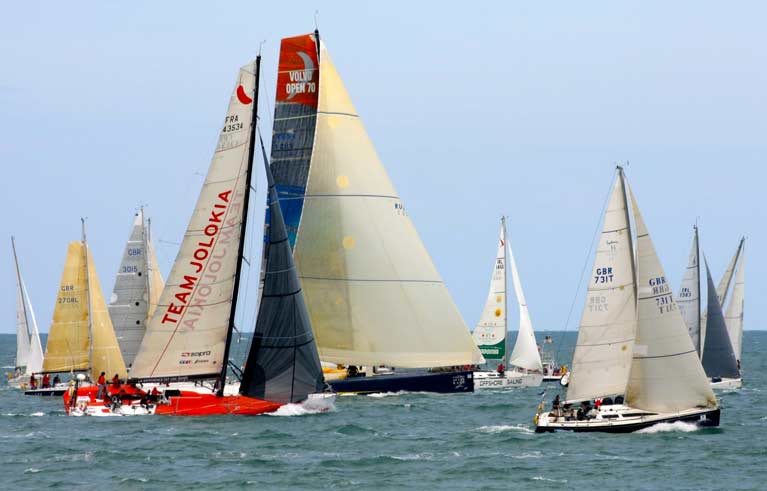 Crazy but it works – the start of the Round Ireland Race 2014 as seen from the Wicklow pierhead
Crazy but it works – the start of the Round Ireland Race 2014 as seen from the Wicklow pierhead
And for those who object to racing where the effect of land regularly intrudes, just remember that the most popular participant sailing events in the world are the Round the Island Race around the Isle of Wight in the south of England, and the Round Gotland Race and other huge events involving close inshore stuff on islands in the Baltic.
Clearly, it’s what people want. And as for fancy Olympic courses in slightly remote area (ie more than two miles away from the harbour), they’re now soooo yesterday……Club sailors want convenience. If they want to go for a sail, they’ll simply go for a sail. But if they want a race, they don’t want to have to go for a sail before it. They want racing, and they want it now.
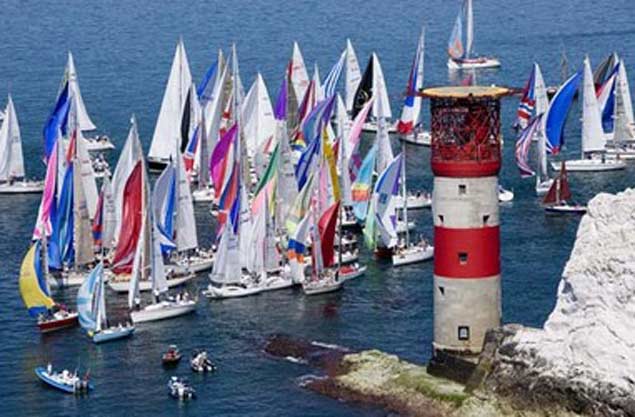 It’s sailing sport of a kind, but definitely not Olympic – the fleet in the Round the Island Race at the Needles, were those really cutting the corner have to be sure they pass safely inside the remains of a hidden shipwreck……
It’s sailing sport of a kind, but definitely not Olympic – the fleet in the Round the Island Race at the Needles, were those really cutting the corner have to be sure they pass safely inside the remains of a hidden shipwreck……
For a while, the ancient Howth 17s were told that the only racing that could be provided for them on a Saturday afternoon would be with the Puppeteer 22s (which carry an outboard auxiliary engine) at a Committee Boat start north of Ireland’s Eye in a supposedly clear area.
Yet if a calm fell, the Seventeens had to resort to a long oar, which was and is brutal to row with, and that’s it. So they rebelled, organized their own Race Officer rota for starts at the old pierhead line which they could reach within minutes from their moorings, and they’ve never looked back since. Saturday afternoon racing is the highlight of the week. So maybe if sailing organisers went by the old dictum of the customer being king, we might see club sailing becoming more healthy.
Here’s a vid of the Round the Island Race which usually starts at an ungodly hour of the morning, yet if you have a handy berth in the outer reaches of Cowes Harbour, you can leave it with just a quarter of an hour to go to your start. We’re not recommending that, but it can be done……
And as for those who like to claim that their nearest “clear area” really does minimize the need for local knowledge almost completely, let us remember the time when John Bertrand, America’s Cup-winning helm for Australia in 1983, finally achieved his true goal in life – becoming Etchells 22 World Champion in 2010, when it was staged in Howth.
For sure, the race area was set in the “clean zone” well clear of Howth, northwards between Ireland’s Eye and Lambay. But despite that, John Bertrand – whose crew for the big event was to include Tom Slingsby – spent six weeks (repeat: 6 weeks) in Howth beforehand, sailing his Etchells 22 morning, noon and night in the race area in order to get a complete feel for it and its many moods. He certainly deserved to win. But a bit of old-fashioned racing using a clear transit-marked shore-based starting line might have been more fun.
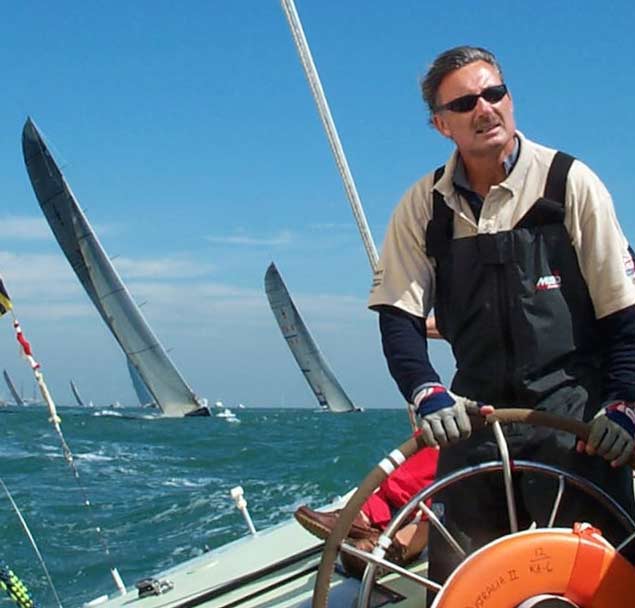 John Bertrand of Australia, who wrested the America’s Cup from the USA in 1983 for the first time since they originally won it in 1851. In 2010, he spent several weeks familiarizing himself with the “clear zone” sailing area off Howth before he raced on it to win the Etchells 22 Worlds
John Bertrand of Australia, who wrested the America’s Cup from the USA in 1983 for the first time since they originally won it in 1851. In 2010, he spent several weeks familiarizing himself with the “clear zone” sailing area off Howth before he raced on it to win the Etchells 22 Worlds



























